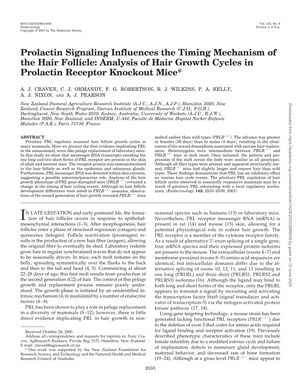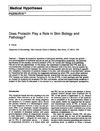Prolactin Signaling Influences the Timing Mechanism of the Hair Follicle: Analysis of Hair Growth Cycles in Prolactin Receptor Knockout Mice
June 2001
in “
Endocrinology
”

TLDR Prolactin affects when mice shed and grow hair.
The study provided the first evidence that prolactin (PRL) is involved in the nonseasonal hair growth cycles of laboratory mice. Researchers found that PRL receptor mRNA transcripts and protein were present in the skin, hair follicles, epidermis, and sebaceous glands of mice, suggesting a potential autocrine/paracrine function for PRL in the skin. In prolactin receptor knockout mice (PRLR−/−), there was a change in the timing of hair cycle events, with these mice experiencing earlier molting than their wild-type counterparts (PRLR+/+), particularly in females (29 days earlier) compared to males (4 days earlier), which eliminated the usual sexual dimorphism in hair replacement. Heterozygous mice showed intermediate molting times. The pattern and progression of molting were similar across all genotypes, and while all hair fiber types were structurally normal, PRLR−/− mice had slightly longer and coarser hair. These results suggest that PRL inhibits hair cycle events in mice, and the regulation of hair follicle cycles by pituitary PRL in seasonally responsive mammals may involve interaction with a local skin mechanism.

